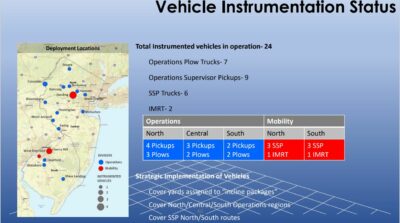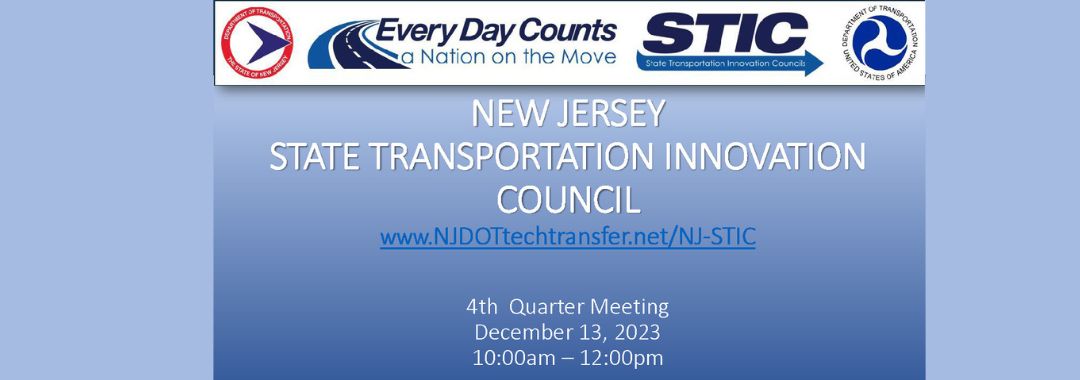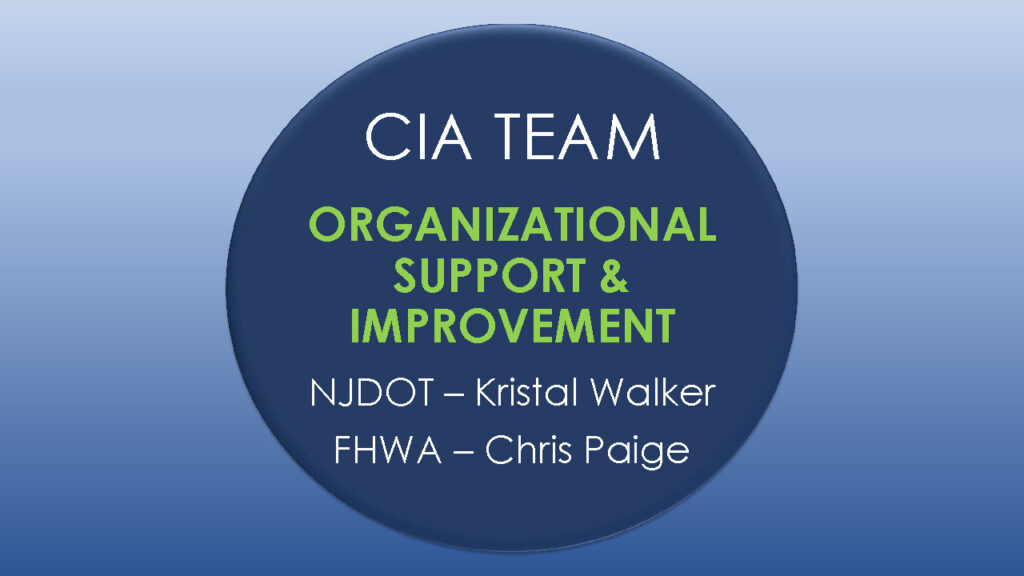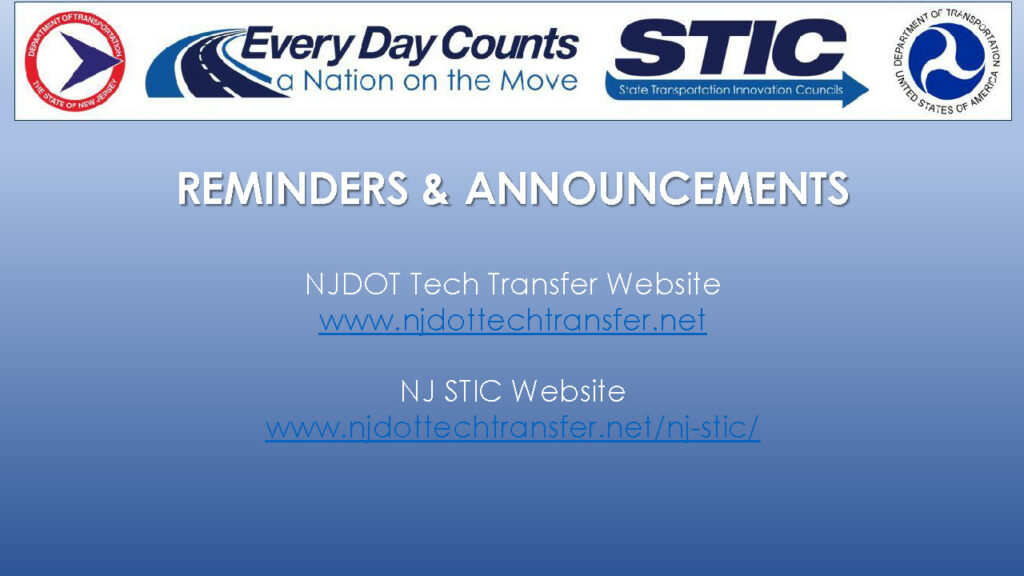The NJ State Transportation Innovation Council (NJ STIC) virtually convened its 4th Quarter Meeting on December 13, 2023. This event provided an opportunity for attendees to hear from the CIA Teams about their progress towards EDC-7 goals and to hear several presentations on mobility and operations topics piloting communications technologies. The agenda for the meeting was distributed in advance of the event.
Welcome Remarks. Amanda Gendek, NJDOT Bureau of Research Manager, greeted those in attendance and opened the meeting. She gave an overview of the day’s agenda and its featured speakers on Mobility and Operations topics describing pilot projects. She also took note of two new changes to the NJ STIC leadership team introducing the new Director of Statewide Planning, Megan Fackler, and the new Assistant Commissioner of Statewide Planning, Safety & Capital Investment, Eric Powers.
FHWA Updates. Christopher Paige, Innovation Coordinator and Community Planner from the FHWA NJ Division Office, provided FHWA updates. Mr. Paige noted upcoming deadlines and the availability of resources, stating the first round of progress report for the EDC-7 round were extended to April 2024. He emphasized that recorded webinars and other resources supporting the EDC-7 innovations are available at the FHWA Center for Accelerating Innovation website. Mr. Paige also encouraged participants to consider pursuing Accelerated Innovation Demonstration (AID) Grants for FY 2024 and noted the recent deadline for FY 2023 had just passed. Additionally, he advised subscribing to the EDC newsletter for updates on transportation innovation activities.
Core Innovation Areas (CIA) Updates. The Core Innovation Area (CIA) Team leaders gave updates on their progress toward fulfilling the deployment goals for their respective innovative initiatives under EDC-7. The updates were given by CIA Team leaders from the NJDOT and FHWA, covering EDC-7 initiatives under the auspices of the CIA Teams for: Safety; Infrastructure Preservation; Mobility and Operations; Organizational Support & Improvement; Mobility and Operations; and Planning and Environment. Each team’s presentation provided insights into their ongoing projects and highlighted some of the milestones and challenges to meeting the goals for the innovations.
Vandana Mathur introduced the presenters who gave mobility and operations-themed presentations that highlighted how communications technologies are being piloted to support more informed decision-making by NJDOT and to manage the operations of transportation systems to ensure the safety of state’s transportation users and workers.

Feature Presentation, Theme #1 — Expansion of the NJDOT Weather Savvy Pilot Program. Thomas Murphy from NJDOT gave an update of the progress of the Weather Savvy Pilot Program aimed at managing and monitoring road conditions during weather events to ensure safety of motorists. The presentation highlighted how trucks have been outfitted with advanced sensors in partnership with a skilled private sector partner. Currently, the program encompasses 24 trucks, strategically distributed to cover major roads across the state. These equipped vehicles play a crucial role in tracking and communicating roadway conditions, contributing significantly to informed maintenance and safety-preserving decisions by sharing this information with central command centers. Looking ahead, there are goals to significantly increase the number of Weather Savvy-equipped vehicles, aiming to reach into the hundreds.

Feature Presentation, Theme #2 — NJDOT Pilot Tests of Truck Parking Information System (TPIS). Luis Rivera from NJDOT discussed the agency’s truck parking pilot program and its recent advancements. He detailed the installation process of micro radar sensors, a key component in the system, which involves precise measurements, coring, cleaning, and securing the sensors with epoxy. Mr. Rivera also introduced the truck parking web portal, designed to offer real-time occupancy data and analytics for rest areas. Highlighting the program’s expansion, he mentioned that it initially began at the Harding Rest Area and has since extended to the rest area at Carneys Point. Mr. Rivera elaborated on the advanced technologies deployed at these locations, including traffic microwave sensors for non-intrusive vehicle detection, CCTV cameras, and pavement sensors, and underscored the program’s commitment to leveraging technology.
Feature Presentation, Theme #3 — No Trucks in the Left Lane Notifications. Kimberly Ferguson from NJDOT explained how NJDOT uses the DriveWyze notification system to improve roadway safety through communication notifications to truck drivers through a phone application and their mandatory electronic logging devices (ELDs). The notifications, strategically placed approximately every 15 miles on multi-lane (3-plus) roadways, are part of an effort to regulate truck lane usage and enhance traffic flow. To determine the optimal locations of these “No Trucks in Left Lane” alerts, Ms. Ferguson described how the NJDOT team has undertaken practical experiments by driving the roadways themselves, ensuring the notifications were helpful and not overwhelming for the truck drivers. This initiative reflects a targeted approach to improve safety and traffic flow on multi-lane roadways.
Feature Presentation, Theme #4 — Traffic Incident Management Outreach Tracker. Ms. Ferguson also discussed the Traffic Incident Management (TIM) outreach tracker in her presentation at the NJ STIC 4th Quarter 2023 Meeting. This tracker is integral to the TIM program, which focuses on training first responders in traffic incident management. The goal for 2023 was to train 5,000 first responders, and while this target was not fully met, significant progress was made with 62 percent of the goal achieved. The TIM outreach tracker plays a crucial role in monitoring the progress of this training initiative. It helps keep track of the number of trained individuals and the effectiveness of the outreach efforts. Ms. Ferguson highlighted the ongoing efforts to increase the number of trained responders, mentioning regular weekly and biannual meetings that support this aim.
NJ STIC Participants Interactive Exercise. Ms. Gendek facilitated an interactive online session with attendees, who were invited to answer a series of questions using their cell phones. The exercise sought to gauge from attendees their perception of the progress towards reaching the deployment goals for the respective EDC-7 innovative initiatives. The session invited feedback and engagement from the participants and enhanced the collaborative aspect of the meeting. The questions invited respondents to consider the deployment status, current challenges, and forms of assistance still needed to reach deployment goals. The exercise sought to solicit from attendees their suggestions for model “innovative” practices and accomplishments that should be featured at future NJ STIC meetings, in future “innovation case study” videos, and in other technical assistance training materials and communications. The results of the interactive exercise are shared here.
Announcements and Reminders
NJDOT Technology Transfer Website Reminder. Attendees were reminded to refer to the NJDOT Technology Transfer website and, in particular, the NJ STIC section. The website is useful for staying up-to-date on NJ STIC activities and developments and for accessing a wide array of NJ STIC content, including an overview of the NJ STIC, the NJ STIC Charter, past meeting summaries, the status of current and past innovative initiatives, NJ STIC Grant Incentive Funding information, and articles and other materials that spotlight innovation and past NJ innovation accomplishments.
NJ Transportation Ideas Portal. Ms. Gendek encouraged attendees to participate in the NJ Transportation Ideas Portal. Available to public for submissions and comments, the portal is open to ideas for future research and implementation studies, and seeks to review and share proposals for innovation topics with the Innovation Advisory Team to determine feasibility for future actions. The deadline for research idea submissions in time for the current round of solicitations is coming soon, December 31, 2023. However, she noted that the portal is always open to new research and innovation idea submissions for consideration for future collaborative efforts and investments.
Innovation Grant Program Announcement. Dr. Venkiteela gave a “sneak-preview” of an upcoming NJDOT Innovation Grant program that is under development. The focus of this initiative will be to encourage innovations, integrate technologies, and foster public-private collaborations. Set to launch in April 2024, the program represents a significant step towards supporting and advancing innovative practices in transportation.
STIC Incentive Funding. Ms. Gendek reminded participants of the availability of STIC Incentive Grants of up to $100,000 annually. This funding is available to support the advancement of innovative initiatives underway, and other noteworthy innovations.
Meeting Schedule Change for 2024. Ms. Gendek mentioned that the schedule for future meetings will be changed to a triannual schedule in 2024. This change will not affect the NJ STIC’s commitment to participate in the national FHWA efforts to promote and accelerate transportation innovations. The council will participate in National STIC network calls and its participation in the next EDC Summit will continue.
Acknowledgements. The session concluded with expressions of gratitude to the guest speakers, CIA Teams, council members, and implementation teams. Their contributions were recognized as pivotal to the meeting’s success and the council’s ongoing endeavors.
A recording of the NJ STIC December 2023 meeting is available here. The day’s presentations can be found here and, in the sections, below, including the results of the interactive exercise.













